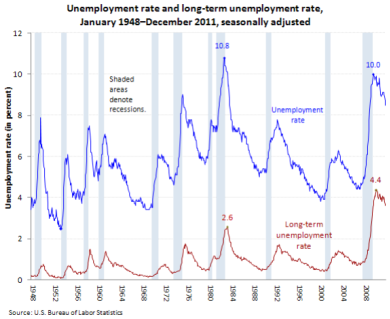Recession Definition and Causes
Â
Per the International Monetary Fund’s Annual Report of 2009, the Great Recession is said to be the worst economic downturn since the Great Depression (International Monetary Fund Annual Report, 2009). The Great Recession officially began December 2007 and ended June 2009 and was a combination of different events that occurred sequentially, starting with the bursting of the housing market bubble due to large number of individuals failing to pay their mortgage. The 8 trillion-dollar housing burst had unwinding effects in the economy; including a sharp decline in consumer spending and business investments and an increase in unemployment due to job loss and job shortage.
Defining Recession
In a greater sense when thinking of an economic recession we associate it with phenomenon’s such as an increasing rate of unemployment, a collapsing housing market and a decline in company profits. But what exactly constitutes as a recession? The National Bureau of Economic Research defines a recession as a “significant decline in economic activity spread across the economy, lasting more than a few months, normally visible in real GDP, real income, employment, industrial production, and wholesale-retail sales” (The NBER’s Recession Dating Procedure, 2008).It is important to note that short periods of reduced economic activities are not considered recessions; instead most analysts believe a recession consists of two consecutive quarters of decline in a countries real GDP. Where real GDP is a country’s gross domestic product taking inflation into account. A typical characteristic of a recession is said to be a decline in real GDP of 2%; more severe cases being up to 5% (Claessens, 2009).
The Great Recession of 2008 Severity

 Figure 1 illustrates the unemployment rate from 1948 until 2011. The graph has recession periods denoted by the shaded areas. When focusing on the 2007- 2009 period we see that in December 2007, the official start of the Great Recession, the United States had an unemployment rate of 5%. By June 2009, the official end of the recession, unemployment had risen to 9.5%. Unemployment rate increased by a total of 4.5% throughout this economic cycle. Figure 1 also depicts the long-term unemployment rate, which is the portion of the unemployed who have been jobless for more than six months. This figure shows that the long-term unemployment rate increased after the Great Recession to 4.4%, higher than it had been during any time of the post war period. (“Unemployment.” U.S. Bureau of Labor Statistics).
Figure 1 illustrates the unemployment rate from 1948 until 2011. The graph has recession periods denoted by the shaded areas. When focusing on the 2007- 2009 period we see that in December 2007, the official start of the Great Recession, the United States had an unemployment rate of 5%. By June 2009, the official end of the recession, unemployment had risen to 9.5%. Unemployment rate increased by a total of 4.5% throughout this economic cycle. Figure 1 also depicts the long-term unemployment rate, which is the portion of the unemployed who have been jobless for more than six months. This figure shows that the long-term unemployment rate increased after the Great Recession to 4.4%, higher than it had been during any time of the post war period. (“Unemployment.” U.S. Bureau of Labor Statistics).
Causations and Implemented Economic Policies
One of the main causes for the Great Recession must do with the unwinding after the burst of the housing bubble. This burst caused the public to get frightened and hold back on spending, resulting in layoffs, which in turn produced less spending in cycle of economic decline. To break this cycle, Keynesians argue that there must be an increase in government spending to ease the public’s tensions, further promote spending, which in turn will save jobs, and stop economic deterioration (Keynesian Economics: The Concise Encyclopedia of Economics).
In his paper “Interpreting the Causes of the Great Recession of 2008”, Joseph E. Stiglitz argues that the main reason why the Great Recession occurred is because of the Federal Reserve bank. He believes the Federal Reserve was ignoring the mounting evidence of a bubble existing in our economy, more specifically a housing bubble.
Conclusion
References
“Business Cycle Dating Committee, National Bureau of Economic Research.” The NBER’s Recession Dating Procedure. N.p., 7 Jan. 2008. Web.
Claessens, Stijn, and M. Ayhan Kose. “What is a Recession.” Finance and Development Mar. 2009: 52-53. Print.
“Job loss.” State of Working America. Economic Policy Institute, n.d. Web. 16 Feb. 2017.
“Keynesian Economics.” Keynesian Economics: The Concise Encyclopedia of Economics | Library of Economics and Liberty. N.p., n.d. Web. 20 Feb. 2017.
International Monetary Fund Annual Report 2009: Fighting the Global Crisis. Rep. N.p.: n.p., 2009: 4. Print.
“The Great Recession.” State of Working America. Economic Policy Institute, n.d. Web. 16 Feb. 2017.
Stiglitz, J. E. (n.d.). Interpreting the Causes of the Great Recession of 2008. Retrieved February 18, 2017.
“Unemployment.” U.S. Bureau of Labor Statistics. U.S. Bureau of Labor Statistics, n.d. Web. 17 Feb. 2017.